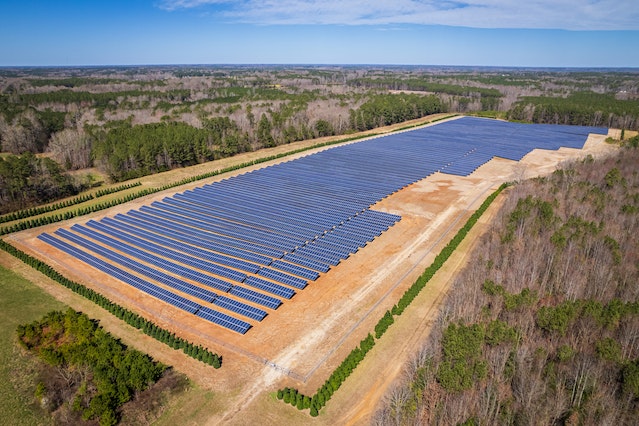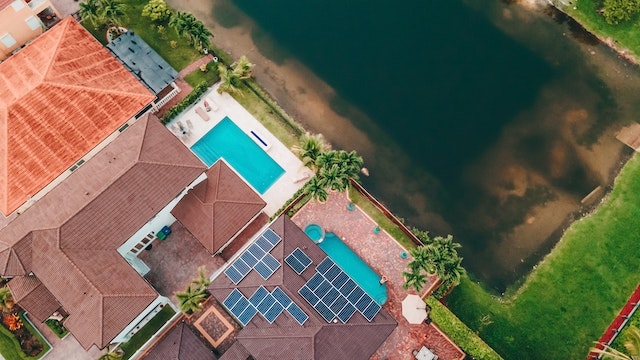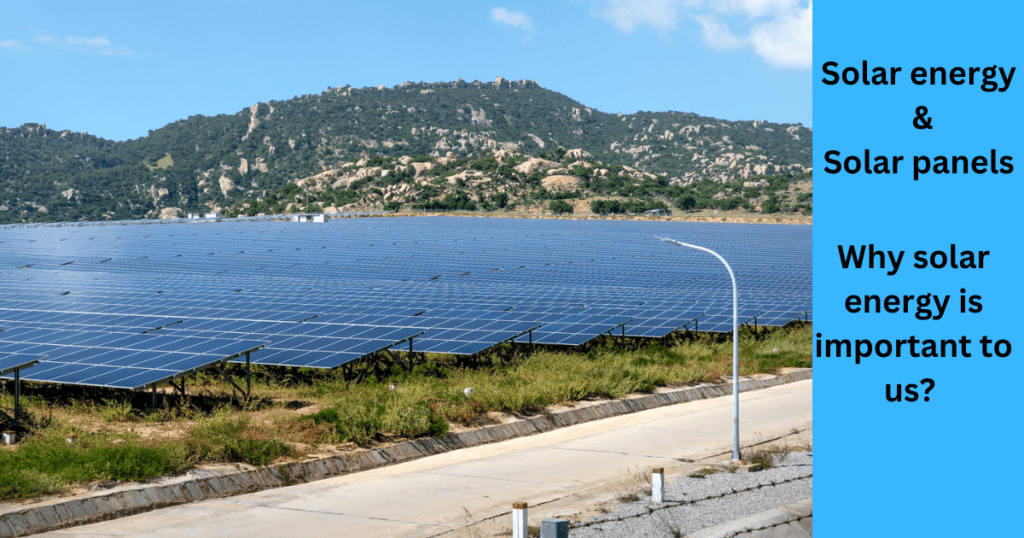Last updated on March 31st, 2024 at 01:11 pm
Solar energy is the everlasting energy source, that has been around us for billions of years, but it was unobserved. Recently, we human beings have found a way to harness its power. Solar energy is the energy that is produced by the sun and is converted into usable electricity by solar panels. It is the most popular renewable energy source and is used all around the world.
In this article, we have shed some light on how solar panels work and why solar energy matters for our planet’s future. We have given a closer look at the basic science of solar cells to the biggest solar energy projects in the world. Are you ready to be amazed by the power of nature? Let’s dive in!
What is solar energy and why is it important to us?
Solar energy is a type of renewable energy that is derived from the sun’s radiation. It is harnessed through the use of solar panels and other solar devices, which can convert sunlight into usable electricity.
Solar energy is considered one of the cleanest and most sustainable sources of energy available, as it produces no greenhouse gases or other harmful pollutants. It is abundant, can be harnessed in almost any location, and has the potential to significantly reduce our reliance on fossil fuels and other non-renewable energy sources.
What is a Solar Panel?
A solar panel is a device that is used to capture and convert solar energy into electricity. It is made up of photovoltaic cells, which are made from silicon and other materials. When sunlight hits the solar panel, it is absorbed by the cells, causing electrons to be released. These electrons are then captured and used to generate electricity.
Do you know? The sun provides enough energy to power the entire planet for a year in just one hour.
The basic science of solar panels and solar cells
You have heard a lot about solar panels, but have you ever wondered, how they work?
A typical solar panel consists of multiple solar cells connected in series and/or parallel to create a solar module. Each solar cell has two layers of semiconductor material with opposite electrical charges. The top layer is doped with (for example) n-type, while the bottom layer is doped with p-type semiconductors.
In order to create this flow of electricity, the solar cell is designed with a depletion region, which is a region of the cell where there are no free electrons. This creates a potential difference between the depletion region and the rest of the cell, allowing electrons to flow from one region to the other and creating a flow of electricity.
When photons from sunlight strike the solar cell, they excite electrons in the n-type layer, causing them to jump across the p-n junction and create a flow of electrons through an external circuit. This flow of electrons is the electrical current produced by the solar cell.
To increase the efficiency of the solar cell, an antireflection layer is often added to the surface of the cell. This layer helps to reduce the amount of sunlight that is reflected away from the cell, allowing more of it to be absorbed and converted into electricity.
![]()
To create a solar panel, multiple solar cells are connected together in a series and/or parallel circuit to create a solar module. In a series circuit, the solar cells are connected end-to-end, with the positive terminal of one cell connected to the negative terminal of the next. This creates a higher voltage output but does not increase the current. In a parallel circuit, the solar cells are connected side-by-side, with all the positive terminals connected together and all the negative terminals connected together. This creates a higher current output but does not increase the voltage.
Finally, the solar module is connected to a charge controller and an inverter to convert the DC electricity produced by the solar cells into AC electricity that can be used to power homes and businesses.
Note: The design of a solar panel and its connections can vary depending on the manufacturer and the specific application, but the basic principles of series and parallel circuits and busbar connections remain the same.
What are the advantages and disadvantages of solar energy?
Advantages:
- Renewable and Sustainable: Solar energy is a renewable and sustainable source of energy. It is derived from sunlight, which is abundant and available everywhere.
- Low Cost: Once the initial installation cost is covered, solar energy is essentially free. The maintenance cost is also minimal.
- No Emissions: Unlike non-renewable energy sources, solar energy does not produce any harmful emissions or pollutants, making it a clean and eco-friendly energy source.
- Independent: Solar energy systems are independent of the grid, which means that they can be installed in remote areas where there is no access to electricity.
- Low Noise Pollution: Solar energy systems are virtually silent, which is a significant advantage in areas where noise pollution is a concern.

Disadvantages:
- Weather Dependence: Solar energy systems are weather-dependent and may not be suitable for areas that experience long periods of cloudy or rainy weather. As a result, solar energy can be used together with another renewable energy source, such as wind energy. The wind-solar hybrid system is a perfect example of that.
- Expensive Installation: The initial installation cost of a solar energy system can be high.
- Land Use: Solar energy systems require a significant amount of land to install, which can be a challenge in densely populated areas.
- Energy Storage: Energy storage technology is not yet advanced enough to effectively store the energy produced by solar energy systems.
- Material Use: The production of solar panels requires the use of rare materials that can have a significant environmental impact.
Fun fact: The sun will continue to produce energy for another 5 billion years, making solar energy a reliable source of power for the foreseeable future.

What are the solar energy products to use at home?
- Solar Panels – These are the most common solar energy products for homes. They are installed on the roof or in the yard and capture sunlight, converting it into electricity.
- Solar Water Heaters – These devices use solar panels to heat water, reducing energy consumption and lowering bills. They are often installed on the roof and can be used in all climates.
- Solar Lights – These are outdoor lights that are powered by solar panels, making them a great way to light up your yard or garden without using any electricity.
- Solar Attic Fans – These fans use solar panels to power their motors, ventilating the attic and reducing the need for air conditioning. They can help save energy and keep your home cool.
- Solar Chargers – These are portable chargers that use solar panels to charge phones, tablets, and other devices. They are great for camping, hiking, and other outdoor activities.
- Solar-Powered Security Cameras – These cameras use solar panels to power their batteries, providing constant surveillance without the need for electricity or wires.
- Solar Cookers – These are devices that use the sun’s energy to cook food. They are great for outdoor cooking and can be used in areas where electricity is not available.
- Solar Pool Heaters – These heaters use solar panels to heat swimming pool water, reducing energy consumption and extending the swimming season.

Impacts of Solar Energy
Impacts of solar energy on the environment and climate change
Solar energy has been found to help mitigate climate change by reducing greenhouse gas emissions, which is critical for protecting humans, wildlife, and ecosystems.
According to the International Energy Agency, solar energy could become the largest source of electricity by 2050, reducing global CO2 emissions by 6 billion tons per year.
Moreover, solar energy can help to improve air quality and reduce water use from energy production, which are vital factors for maintaining a healthy environment.
Impact of solar energy on the conservation of water resources
Traditional power generation processes require a significant amount of water for cooling and other processes. However, solar energy systems require little or no water to generate electricity, thus conserving water resources. According to the National Renewable Energy Laboratory, a typical 1 MW solar power plant can save about 800,000 gallons of water per year.
Impact of solar energy on the economic growth
Solar energy has had a positive impact on the economy by creating jobs in the renewable energy sector. According to a report by the International Renewable Energy Agency, the renewable energy sector employed over 11 million people worldwide in 2018, with solar energy being the largest employer within the sector.
The economics of solar energy is growing with time. This means that solar energy has the potential to create a significant number of jobs, both directly in solar manufacturing and installation, as well as indirectly in related industries such as transportation and construction.
Additionally, the increasing demand for solar energy has resulted in a decline in its costs, making it more accessible to individuals and businesses. This affordability has led to increased investment in solar projects, which in turn stimulates economic growth.
As a result, the solar energy market is expected to continue growing in the coming years, which will further increase job opportunities and contribute to economic development.
Impact of solar energy on society
Solar energy provides greater energy independence to communities and reduces their reliance on fossil fuels. This can also help to stabilize energy prices, making energy more affordable and accessible to everyone.
Additionally, solar energy can provide access to electricity in remote and underdeveloped areas that are not connected to the grid. This can have a transformative impact on the quality of life of individuals and communities, particularly those in developing countries.
Which countries use solar power the most?
According to the World Population Review data, here is the list of the 10 countries which use solar power the most.
- China: China is the world’s largest producer of solar energy, with over 306,973 MW of solar power capacity installed as of 2021. China has invested heavily in solar energy in recent years and has set ambitious targets for its future expansion of solar power capacity.
- United States: The United States is the second-largest producer of solar energy in the world, with 95,209 MW of solar power capacity installed as of 2021. The growth of solar power in the US has been driven by decreasing costs and government incentives, such as tax credits for solar installation.
- Japan: Japan has the third-largest solar energy capacity in the world, with 74,191 MW installed as of 2021. Japan has a long history of investing in solar energy and has one of the most robust feed-in-tariff programs in the world, which has helped to drive the country’s solar power growth.
- Germany: Germany is the fourth-largest producer of solar energy in the world, with 58,461 MW of solar power capacity installed as of 2021. Germany has been a leader in the development of solar energy technology and has implemented policies to support the growth of solar power, such as feed-in tariffs and subsidies.
- India: India has the fifth-largest solar energy capacity in the world, with 49,684 MW installed as of 2021. India has set a target of achieving 100 GW of solar power capacity by 2022 and has implemented various policies and incentives to support the growth of solar power, such as tax exemptions and subsidies.
- Italy: Italy has 22,698 MW of solar power capacity installed as of 2021. Italy has been investing in solar power since the early 2000s and has implemented feed-in tariffs and other policies to support the growth of solar energy.
- Australia: Australia has 19,076 MW of solar power capacity installed as of 2021. Australia has been increasing its investment in solar energy in recent years, and has set a target of achieving 50% renewable energy by 2030. The growth of solar power in Australia has been driven by decreasing costs and government incentives.
- South Korea: South Korea has 18,161 MW of solar power capacity installed as of 2021. South Korea has been increasing its investment in solar energy in recent years and has set a target of achieving 20% renewable energy by 2030. The growth of solar power in South Korea has been driven by decreasing costs and government incentives.
- Vietnam: Vietnam has 16,660 MW of solar power capacity installed as of 2021. Vietnam has been investing in solar energy in recent years, and has set a target of achieving 12 GW of solar power capacity by 2030
- Spain: Spain has a total solar energy capacity of 15,952 MW. In 2020, Spain added 2.6 GW of solar capacity, making it the third-largest solar market in Europe that year.

What are the biggest solar power plants in the world?
Here is the list of the eight biggest solar-powered projects in the world as of the current date :
- Bhadla Solar Park, India – 2.25 GW: This solar park, located in Bhadla village, Rajasthan’s Jodhpur district, is currently the largest solar power plant in the world with a capacity of 2.25 GW .
- Huanghe Hydropower Hainan Solar Park, China-2.2GW: This solar park, is located in Qinghai, China. This is the second-largest solar power plant in the world with a capacity of 2.2 GW.
- Pavagada Solar Park, India-2.05W: This solar park, located in Karnataka’s Tumkur district, is currently the third largest solar power plant in the world with a capacity of 2.05 GW.
- Benban Solar Park, Egypt – 1.8 GW: Located in eastern Egypt, the Benban Solar Park is currently under construction and, when completed, will become the largest solar installation in the world, with a capacity of 1.8 GW.
- Tengger Desert Solar Park, China-1.5 GW: This solar park is located in Zhongwei, Ningxia, China with a capacity of 1.5 GW.
- Noor Abu Dhabi Solar Plant, United Arab Emirates – 1.18 GW: The Noor Abu Dhabi Solar Plant, located in the United Arab Emirates, has a capacity of 1.18 GW, making it the largest single-site solar power plant in the world. It consists of over 3.2 million solar panels and can power up to 90,000 homes.
- Villanueva Solar Power Plant, Mexico – 828 MW: The Villanueva Solar Power Plant, located in the state of Coahuila, is currently the largest solar plant in the Americas, with a capacity of 828 MW. It comprises over 2.3 million PV modules.
- Solar Star, United States – 579 MW: Located near Rosamond, California, Solar Star was completed in March 2015 and was, at the time, the largest solar power project in the world, with a capacity of 579 MW. It consists of over 1.7 million solar panels.
What are the most high-efficiency solar panels available in the market?
- Canadian Solar: Manufactured by Canadian solar inc. It has 23.81% conversion efficiency for n-type large area multi-crystalline silicon solar cell and offers a power output of 440w.
- SunPower Maxeon 6: Manufactured by SunPower, it has an efficiency rating of 22.8% and offers a power output of 440 W.
- Longi Solar Hi-Mo 6: Manufactured by Longi Solar, it has an efficiency rating of 22.6% and offers a power output of 440 W.
- REC Alpha pure R: Manufactured by REC Group, it has an efficiency rating of 22.3% and offers a power output of 430 W.
- Tiger Neo: Manufactured by Jinko Solar, it has an efficiency rating of 22.2% and offers a power output of 480 W.
- Trina Solar Vertex S: Manufactured by Trina Solar, it has an efficiency rating of 21.3% and offers a power output of 425 W.
Note: It is important to note that high-efficiency solar panels tend to come with a higher price tag compared to regular efficiency panels.
Which countries are the leading manufacturer of solar panels in the world?
Solar cells are manufactured in large quantities across multiple countries, including China, Japan, South Korea, Taiwan, Malaysia, the United States, and several European nations like Germany, France, and Italy.
China is currently the largest manufacturer of solar cells and modules, producing over 70% of the world’s total solar cells in 2021. Based on the 2022 data provided by the International Energy Agency (IEA), China accounts for 74.7% of solar modules, 85.1% of solar cells, and 96.8% of wafers produced globally.
In terms of installed solar systems, China, the United States, and Europe continue to lead the market. In 2021, China became the first country to install over 50 GW of solar PV in a single year. Other nations with significant installed solar capacity include the United States, Japan, Germany, India, and Australia.
The global PV cell/module production industry has seen steady growth. As of 2021, the total global production capacity for solar cells and modules was around 800 GW, up from 600 GW in 2019. Despite the challenges posed by the COVID-19 pandemic, the industry has continued to see strong growth, with a 31% increase in solar installations in 2020.
What is the future of solar energy?
The future of solar energy looks promising as it is becoming increasingly competitive with fossil fuels in terms of cost and efficiency.
Solar panel technology is rapidly advancing, with new developments such as perovskite, CIGS and tandem solar cells showing great potential. As a result, solar energy is expected to become even more affordable and accessible in the coming years.
Governments and businesses around the world are also making significant investments in solar power, with many setting ambitious targets for increasing the use of renewable energy.
Additionally, the growing concern over climate change and the need to reduce carbon emissions is expected to drive further growth in the solar industry. Overall, the future of solar energy appears bright and full of potential for continued growth and innovation.
Wrapping up!
In conclusion, solar energy is a renewable energy source that works by harnessing the power of the sun to generate electricity. Solar panels absorb sunlight and convert it into direct current (DC) electricity, which is then converted into alternating current (AC) electricity through an inverter. The electricity can then be used to power homes, businesses, and other applications.
Solar energy matters because it is a clean and sustainable alternative to traditional fossil fuels that produce harmful greenhouse gas emissions. It can reduce our reliance on non-renewable resources, improve air quality, and mitigate the impact of climate change.
Additionally, as technology advances, the cost of solar energy is decreasing, making it more accessible to a wider range of individuals and communities.
Overall, solar energy has the potential to play a significant role in transitioning towards a more sustainable future.
Sources:
National Geographic: https://www.nationalgeographic.com/
IRENA: https://www.irena.org/
International Energy Agency (IEA): https://www.iea.org/
US Department of Energy: https://www.energy.gov/

